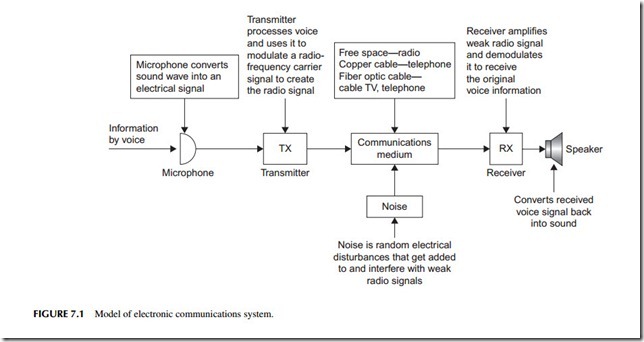INTRODUCTION
First they called it wireless. Then they called it radio. Today, the term wireless is trendy again. Whatever you call it, radio is communication over a distance without any physical connection. Radio is cool because it is completely silent and invisible. It can occur over a distance of only a few feet, all the way around the world, or between planets and spacecraft. Radio, despite the fact that it has been around for over a century, and the fact that we take it for granted on a grand scale, is truly black magic. When you finish reading this chapter, you will know how this magic works.
RADIO COMMUNICATION SYSTEMS
Radio is an electronic communications system. All electronic communications systems have the basic form shown in Figure 7.1, whether it is a wired or wireless system. The information to be communicated, usually voice, is first converted into an electrical signal by a microphone. That signal is then processed by the circuits in a transmitter (TX), and then sent via a communications medium to a receiver (RX) that processes the signal and converts it back into voice by a speaker or headphones. In the telephone system, the communications medium is a cable made of copper wire. In a cable TV sys- tem, the medium is a coaxial cable, twisted-pair cable, or fiber optic cable. But in radio, the communications channel is free space. The radio signal travels from one place to another almost instantaneously and it passes right through
most obstructions like walls, buildings, smog, trees, and even people. Note that noise is added to the signal as it passes through the channel or medium.
Noise
Noise is any random electrical voltage that interferes with the weak radio signal. Noise comes from the atmosphere, space, human-made objects, and electronic components. Atmospheric noise is lightning. Space noise comprises random signals from the Sun and remote stars. Human-made noise comes from electrical power generation, distribution, and switching. It also comes from fluorescent lights, motors, auto ignitions, and many other sources. The worst noise comes from the electronic components that actually process the weak radio signal. Resistors, transistors, and integrated circuits generate random noise because of thermal agitation. Heat produces random movement of the electrons in the components, and that produces a noise voltage which is added to the radio signal. Even though noise voltages are very small (microvolts or nanovolts), they are still large enough to interfere with and in some cases obliterate the very small received radio signal. In most radio systems, it is noise that limits intelligibility, transmitted data speed, and transmitted distances.
